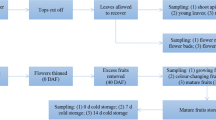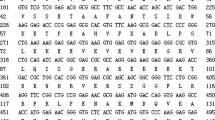Summary
In Achlya ambisexualis, hsp85 is one of the characteristic mycelial heat shock proteins induced in response to a rapid elevation in temperature (Silver et al. 1983). This heat shock protein has the same electrophoretic mobility on two-dimensional gels and is antigenically related to an 85 kDa steroid hormone-regulated protein which constites a component of the putative Achlya steroid hormone-receptor complex. We report here the isolation of two distinct, yet highly related, hsp85 gene sequences from Achlya genomic libraries. Northern analyses, using these two Achlya genomic sequences as probes, suggest that there are two hsp85 message population in Achlya and that at least one of these is regulated by the steroid hormone antheridiol.
Similar content being viewed by others
References
Arsenault GP, Diemann K, Barksdale AW, McMorris TC (1968) J Am Chem Soc 90: 5635–5636
Barksdale AW (1969) Science 166: 831–837
Barksdale AW, Lasure LL (1973) Bull Torrey Bot Club 100: 199–202
Barnier JV, Bensaude O, Morange M, Babinet C (1987) Exp Cell Res 170: 186–194
Bedard P-A, Brandhorst BP (1986) Dev Biol 117: 286–293
Borkovich KA, Farrelly FW, Finkelstein DB, Taulien J, Linquist S (1989) Mol Cell Biol 9: 3919–3930
Brunt SA, Silver JC (1986a) Exp Cell Res 163: 22–34
Brunt SA, Silver JC (1986b) Exp Cell Res 165: 306–319
Brunt SA, Silver JC (1987) Exp Mycol 11: 65–69
Brunt SA, Riehl S, Silver JC (1990) Mol Cell Biol 10: 273–281
Catelli GC, Binhart N, Feramisco JR, Helfman DM (1985) Nucleic Acids Res 13: 6036–6047
Dodd JG, Horgen PA, Straus NA (1975) Cytobios 13: 31–36
Farrelly FW, Finkelstein DB (1984) J Biol Chem 259: 5745–5751
Feinberg AP, Vogelstein B (1983) Anal Biochem 132: 6–13
Groner B, Hynes N, Sippel AE, Schutz G (1976) Nature 261: 599–601
Gwynne DI, Brandhorst BP (1980) Exp Mycol 4: 251–259
Haire RN, Peterson MS, O'Leary JJ (1988) J Cell Biol 106: 883–891
Hickey E, Brandon SE, Sadis S, Smale G, Weber LA (1986) Gene 43: 147–154
Hickey E, Brandon SE, Smale G, Lloyd D, Weber LA (1989) Mol Cell Biol 9: 2615–2626
Holmgren R, Livak K, Morimoto R, Freund R, Messelson M (1979) Cell 18: 1359–1370
Holmgren R, Corses V, Morimoto R, Blackman R, Messelson M (1981) Proc Natl Acad Sci USA 78: 3775–3778
Horgen PA (1981) In: O'Day DH, Horgen PA (eds) Sexual interactions in eukaryotic microbes. Academic Press Inc, New York, pp 155–178
Horton JS, Horgen PA (1985) Can J Biochem Cell Biol 63: 355–365
Lees-Miller SP, Anderson CW (1989) J Biol Chem 264: 2431–2437
Linquist S, Craig EA (1988) Annu Rev Genet 22: 631–677
Michalski CJ (1978) Biochem Biophys Res Commun 84: 417–427
Moore SK, Kozak C, Robinson EA, Ullrich SJ, Appella E (1989) J Biol Chem 264: 5343–5351
Mottram JC, Murphy WJ, Agabian N (1989) Mol Biochem Parasitol 37: 115–128
Ng R, Abelson J (1980) Proc Natl Acad Sci USA 77: 3912–3916
Pekkala D, Silver JC (1987) Exp Cell Res 168: 325–337
Pekkala D, Silver JC (1990) Exp Cell Res 187: 16–24
Pekkala D, Heath IB, Silver JC (1984) Mol Cell Biol 4: 1198–1205
Rebbe NF, Hickman WS, Ley TJ, Strafford DW, Hickman S (1989) J Biol Chem 264: 15006–15011
Sambrook J, Fritsch EF, Maniatis T (1989) Molecular cloning: a laboratory manual 2nd edn. Cold Spring Harbor Laboratory, Cold Spring Harbor, New York
Silver JC, Horgen PA (1974) Nature 249: 252–254
Silver JC, Andrews DR, Pekkala D (1983) Can J Biochem Cell Biol 61: 447–455
Timberlake WE, Orr WC (1984) In: Goldberger RF, Yamamoto KR (eds) Biological regulation of development, vol 3 B. Plenum Publishing Corp, New York, pp 255–283
Ullrich SJ, Robinson EA, Law LW, Willinghan M, Appela E (1986) Proc Natl Acad Sci USA 83: 3121–3125
Ullrich SJ, Moore SK, Appella E (1989) J Biol Chem 264: 6810–6816
Walter T, Drabent B, Krebs H, Tomalak M, Heiss S, Benecke B-J (1989) Gene 83: 105–115
Author information
Authors and Affiliations
Additional information
Communicated by H. Bertrand
Rights and permissions
About this article
Cite this article
Brunt, S.A., Silver, J.C. Molecular cloning and characterization of two distinct hsp 85 sequences from the steroid responsive fungus Achlya ambisexualis . Curr Genet 19, 383–388 (1991). https://doi.org/10.1007/BF00309599
Received:
Issue Date:
DOI: https://doi.org/10.1007/BF00309599




